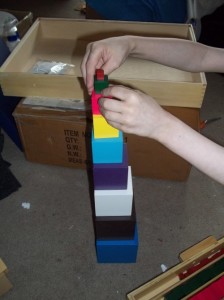Getting Started with Elementary Montessori Homeschooling
Useful tips for starting a new classroom or transitioning in new-to-Montessori children as well.
Over the years, there have been numerous blog posts and other articles helping parents get started with Montessori homeschooling; most of these articles are addressed to the primary level; a few to elementary. None really get to the heart of the matter. Dr. Montessori intensely observed the child and his inner workings, observing what has been there since the moment of creation – and found a way to provide for what she discovered. On the one hand, nothing magical; on the other hand, so profound that it affects our very being – because that is what she observed – the depth of the human soul. Thus Montessori is about more than materials and lesson plans (album pages), more than the academics… it gets down deep and the environment MUST reflect this depth in order to achieve the true fulfillment of the child.
Elementary is compatible with primary, if you have children of both ages in your home; but it is NOT the same. The needs and tendencies are the same, the core response is the same (respect, follow the child), but the outward signs are different. Why? Because the elementary child is now in the second plane of development, which brings about a set of changes. A need for order? Yes! but order has now been internalized and the child no longer feels the need to keep order in his outer environment – now we must be very conscious about keeping our space cleaned up out of respect for the other persons in the environment and not for our own internal development. Among many other examples.
So how do we get started with Montessori homeschooling at the elementary level? What if your child has had no Montessori background or is even approaching the adolescent years. Let’s take a look at what remains the same. First some previously posted articles of interest that remain pertinent to our needs in this article – these apply to both primary and elementary, with my elementary additions:
- Montessori Homeschooling – How to get Started Montessori http://montessorihomeschooling.blogspot.com/2008/03/how-to-get-started-montessori.html
- I would modify this to include Volume 2 of The Advanced Montessori Method (available free online through Google Books) as well as the obtaining of a keys-based theory album (see below)
- Simple Homeschool – 8 Principles (to get started while you are adapting your environment to a Montessori environment – there are great transitional ideas here! All the principles apply to each age level) http://simplehomeschool.net/montessori-at-home/
Thoughts to keep in mind as you FOCUS ON THE KEYS:
- A set of Montessori albums (manuals, lesson plans) will be your “keys” – your academic teasers to get the children working on their own interests.
- The children should be exploring their own interests; and you will need to pull in resources according to those interests.
- You do NOT need the most expensive manuals with every possible interest included. You want something reasonably-priced with the *keys* so that you have both time and money to do what you need to do with your child’s interests.
- You WANT a theory album to explain all the background in every day applicable terms.
- The elementary level is OPPOSITE the primary level in the following key ways:
- If the child is not yet reading/writing, reading will typically come first. (in primary, writing was first)
- We will now provide the BIG picture first; then go back and fill in the details. We will provide that big picture every single year of elementary – so there is plenty of time to come back to it; they don’t need to get everything the first year. (in primary, we start with the most basic) – Cosmic Education (everything is inter-connected) – the big picture is told via stories called the Great Lessons.
- It is NOT necessary to finish the primary albums before moving into elementary, if you have AMI (keys) albums that provide for what to do with children who didn’t finish or didn’t do primary Montessori.
So how do I suggest getting started?
(these tips are good regardless if you are new to Montessori altogether or are transitioning from primary to elementary or even if your children are nearing or even in adolescence)
- Follow the steps in the two articles above. This is just to get started in laying the foundation. Add in the book Volume 2 of The Advanced Montessori Method (available free online through Google Books) – just the background portions to get a feel for things. Purchase your core set of albums, or at least the “theory” album. Hint: if the set of albums does not contain theory, it probably won’t suit your homeschool needs at this time; these other album options can be added later if you find your child has particular interests.
- Focus on de-cluttering your home. Don’t get rid of anything just yet (you’ll end up wanting some of that stuff back) – just clear it out of the main living areas. Do get it out of the way – what is the purpose(s) of each room, just have what you need there. You do not need 5 tools to do the same job. You do want your children to have access to the tools they need. Consider placing strong chemicals in a high-up cabinet so that the accessible cabinets contain safe items. Consider replacing your cleaning chemicals with safe substances your children can use with you.
- IF you are transitioning from primary, you will be removing a LOT of trays (or keep the trays for your other littles). The elementary child now has things he needs in more logical places. Science experiments are only trays for the teacher demonstration, and when the child goes to the supply shelf to gather his needed supplies. He does NOT need everything laid out for him on a tray anymore. Trays at the elementary age, for the most part, are an insult to his intelligence. Yes, a nice basket of interesting items, requested by the child or presented once in a while by the adult is a great way to entice an interest, but that doesn’t look like primary 😉
- WITH your children, make any necessary repairs on found items. These practical life skills are HUGE to the foundation of an elementary child’s education. And a very strong preparation for a fantastic adolescent experience.
- WITH your children, truly clean the house. Same idea with the practical life skills. Use those safe cleaners (white vinegar, baking soda and citric acid go a LONG way; add some washing soda and borax and 99% of your cleaning is done). Use those large muscles and those tiny muscles. CARE about the environment and show them how to do so as well.
- On your cleaning breaks: Begin telling the Great Lessons. Just the stories, with the included experiments. You’ll pull your supplies from what you have, only buy what you need for these lessons.
- Work on remedial language skills IF needed. 5 minutes at a time, interspersed throughout the day – the needed keys should be in your elementary Montessori language album. The ideal is that a 1st grader can read at what the public schools consider a 3rd grade reading level. By 2nd grade, a Montessori child utilizing KEYS, will be reading at middle/high school level and your only concern from there is keeping up with maturity in regards to topics.
- Where do your children’s interests lead? Establish the pattern of hearing a story, exploring what we think about it, what entices us, what questions do we have (write those questions down and expect them to find answers, sometimes with your help), what do we want to DO with this new knowledge (write that down too). The children can copy the chart, re-create the charts in another way, repeat experiments, seek out further information on a key point of interest…. If they have more than one idea, write down the other ideas to save for another day. Encourage a point of completion – write down the question and the answer found; draw pictures; collect ideas in a notebook; create a poster; etc. Around this time you will also be starting to work on work plans and journals – as you are comfortable and find the need for accountability, it will come more naturally. Not every story or presentation will lead to self-designed follow-up; be ok with that, but also be encouraging of the child asking questions, going further, and EXPLORING.
- (this step might be a month or more in) With your chosen set of albums, go through the early math lessons to find where your child is. Keep it fun and interesting – let your child show you what they know. Let them know this is what you are doing (show a material, state its purpose and say, “show me what you know, I’ll fill in the rest”). Do NOT worry about the age on the album pages when you are starting – just focus on finding where your child is since the sequence is very different from every other math option out there. Begin where needed and move forward from there. Hint: Good elementary math albums include a section on what to do with children who have had no (or limited) primary experience. Do not start a typically developing elementary child in the primary math album.
- Getting into the rest of the albums. By now, you should find that you are using most or at least half of the subject albums based on the child’s interests (geography, music, biology, history) and the basic skills (math, language, geometry). Add in the remaining subjects when appropriate for your family.
There you have it: 10 Steps to Elementary Montessori Homeschooling.



2 Responses to Getting Started with Elementary Montessori Homeschooling